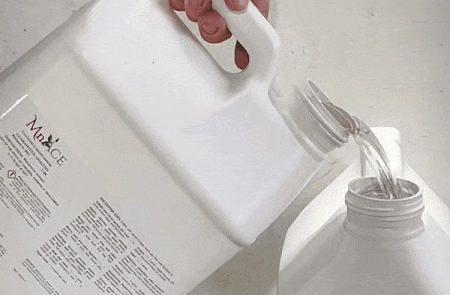Monsters in Minnesota: Liquid Phosphate and Acetate Foliar Fertilizer Affects
Something miraculous happens when the clock strikes midnight on August 31, and the calendar flips from August begrudgingly to September. Instantaneously, pumpkins and Halloween decorations seemingly sprout from nowhere. And while the magic date was September 1 this year, the Halloween hostile takeover continues to creep increasingly into Summer territory. As everyone else is doing it seems to be the motto, I might as well get along with the trend, too. With Halloween ever present, it only seems fitting to give an update on how our liquid phosphate fertilizer has affected the monster Beets up in Minnesota.
Chuck Peppell, our North Central representative, has been hot on the case, digging with dogged determination every few weeks to unearth sugar beets for comparison.
And what he’s found is encouraging, to say the least; fueled by torrential rains every other day, the crop has thrived, and those beets treated with Free Phos 24 in particular
have prospered. Chuck’s most recent excursion yielded these shocking results as seen in the photo below. The beet on the left was left untreated, and the beet on steroids to the right, treated with Free Phos 24 liquid phosphate fertilizer.
The results so far have been nearly unbelievable, and had I not dug plants from the plot earlier in the year, I would be hard-pressed to believe them myself.
Shortly after, Chuck sent this photos. Minn-dak and the grower decided to harvest one end of the field early to make access easier during harvest time. This is where we received even more good news. Minn-Dak tested the harvested beets for sugar percentage, and the results were sweet indeed.
Batches were randomly tested for sugar The non-treated beets returned sugar percentages of 12.69%, 12.17%, 12.15%, 11.91%, 11.95%, 11.58%, 11.22%.
The Free Phos 24 liquid phosphate fertilizer treated beets returned sugar percentages of 13.02% and 12.29%.
This means Free Phos 24 treated beets had the highest sugar content in the preliminary harvested beets. Logically, this seems intuitive. Phosphate is a precursor to ATP and, therefore, sugar. More phosphate in the plant should equal more sugar. This is especially significant for growers looking to optimize sugar content, as it reinforces the role Free Phos plays in enhancing overall crop quality.
While this trial isn’t done yet, it is progressing well! As the data continues to roll in, we expect even more promising results that highlight the benefits of using Free Phos 24 to boost both yield and sugar production in crops.
Ghosts in the Spray Tank
In June, Chad Calhoun, our Midwest representative and I headed to Northwest Indiana to meet with a grower who had a nightmarish tale. This area of Northwest Indiana has organic matter levels that could exceed 60%, colloquially referred to as muck ground.
The consequence of high organic matter is low availability of manganese and copper. Low manganese results in lower grain yield due to lower pollen fertility and carbohydrate supply. In addition to low yield, low manganese availability reduces chlorophyll production (manganese assists iron in this function). The remedy? A foliar application of a liquid manganese fertilizer would bypass the soil conditions, causing a tie-up. That is if the foliar application of a liquid manganese fertilizer utilized a plant-available form of manganese. This is where we come to the crux of our terrifying tale. The grower made application after application after application of a 13% manganese EDTA as a liquid manganese foliar spray. While saying Beetlejuice 3 times worked to conjure Michael Keaton in the film of the same name (that reference is a bit of a reach, but I’m trying to continue the theme here), three spray applications of the 13% manganese EDTA failed to coax manganese into the plant.
For the grower, it was eerie; he poured the product into the spray tank and watched it come out during application, but it disappeared, failing to correct visual deficiency symptoms or raise tissue sample numbers. It was like seeing a ghost, something that was there one moment but gone the next, evaporating before his eyes. This grower was shocked when Chad explained that EDTA fertilizers were initially made only as soil-applied products. The grower was further surprised to learn that EDTAs are large molecules competing against the pores on plant leaves and have low absorption rates. He was stunned when Chad showed him a photo of all the chemical bonds tightly binding a nutrient in EDTA form. The grower was distraught until Chad proposed using Cultivace liquid manganese fertilizer as a manganese foliar spray.
Acetates, Chad stated, are small and highly reactive, aren’t bound tightly, and are recognized by plants as plants produce acetic acid. The grower decided to give it a try. Earlier this month, we followed up with the grower. He was thrilled.
While three applications of a 13% manganese EDTA were used, one application of a liquid 5% manganese acetate foliar spray at a rate of 2 quarts per acre drove plant manganese levels from deficient to sufficient. The visual deficiency symptoms were corrected as a result. In fact one application of Mn Ace resulted in a 15% tissue concentration manganese increase over the three 13% EDTA mn Applications .
RESULTS
This result underscores the clear advantage that acetate-based foliar fertilizers offer over EDTA formulations. Acetates, with their smaller molecular size, are more easily absorbed by plant leaves, leading to faster nutrient uptake and more immediate correction of deficiencies.
In contrast, EDTA, though effective when used as a soil-applied product, struggles to provide the same efficiency when applied foliarly. The difference in molecular structure makes acetate foliar sprays more bioavailable, allowing plants to quickly assimilate and utilize the nutrients delivered. Growers who rely on acetate foliar fertilizers can see noticeable improvements in both crop quality and speed of recovery from deficiencies, as opposed to repeated, and often ineffective, applications of EDTA foliar fertilizers.
This only serves to fortify what CultivAce’s founder and owner Wayne Sledge proposed in his webinar on EDTAs vs Acetates. EDTA fertilizer should remain as soil-applied products only. Foliar application of EDTA fertilizers only result in disappointment and money lost for the grower.
The evidence continues to demonstrate that acetate foliar fertilizers are the superior choice for correcting nutrient deficiencies quickly and efficiently. The rapid uptake, coupled with the ability to use fewer applications, provides a significant return on investment for growers. EDTA formulations still have their place, but their role should be limited to soil applications where they perform best. For foliar applications, growers should turn to acetate-based solutions for a more effective, cost-efficient approach to plant nutrition.





